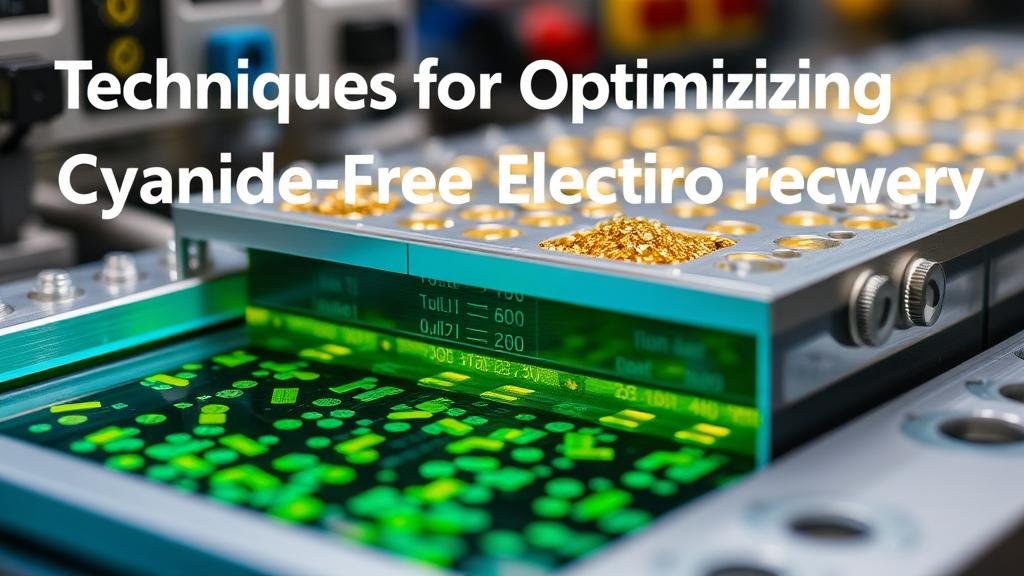Techniques for Optimizing Cyanide-Free Electrochemical Gold Recovery
Techniques for Optimizing Cyanide-Free Electrochemical Gold Recovery
The quest for sustainable and environmentally friendly methods of gold recovery has accelerated in recent decades due to the ecological hazards posed by traditional cyanide-based techniques. Electrochemical gold recovery has emerged as a promising alternative, particularly when combined with innovative techniques that optimize performance while remaining cyanide-free. This article discusses various methods employed to enhance the efficiency of electrochemical processes in gold recovery, emphasizing their practical applications and potential benefits.
Understanding Electrochemical Gold Recovery
Electrochemical gold recovery involves using electrolysis to extract gold from its ore or from electronic waste. This technique operates by applying an electric current to a circuit containing the target metals in solution, leading to electrochemical reactions that deposit gold onto electrodes. The fundamental advantage of this method is its reduced environmental impact compared to conventional processes that rely heavily on toxic reagents like cyanide.
Key Techniques for Optimization
Several techniques can be employed to enhance the efficiency of cyanide-free electrochemical gold recovery. These include optimizing operational parameters, using advanced materials for electrodes, and employing innovative technologies to enhance ion mobility.
- Operational Parameter Optimization: Manipulating factors such as pH, temperature, and current density can significantly impact the recovery rate. For example, studies have shown that operating at an optimal pH of around 4.0 can increase gold recovery rates by over 20% due to enhanced ionization of gold complexes.
- Advanced Electrode Materials: The choice of electrode material plays a crucial role in electrochemistry. Utilizing materials such as carbon nanotubes or graphene improves the conductivity and active surface area, leading to higher gold deposition rates. Research indicates that electrodes made from these advanced materials can double the efficiency compared to traditional platinum electrodes.
- Ion Mobility Enhancement Techniques: Useing additives like surfactants can enhance ion mobility in the electrolyte solution. This is akin to how a surfactant in detergent helps to disperse grease–a similar principle applies here, making gold ions more accessible and improving the overall recovery rate.
Real-World Applications
Several industries are currently leveraging these techniques for effective gold recovery. For example, the electronics recycling industry benefits from cyanide-free methods as they deal with e-waste, which contains precious metals. Companies like Umicore and Mineworx are developing and implementing electrochemical processes that effectively recover gold without toxic substances, aligning with global sustainability objectives.
Also, research institutions have been conducting trials demonstrating the application of ion exchange methods combined with electrochemical techniques, showing recovery rates exceeding 95%. For example, a study assessing the viability of these processes in Brazil highlighted the feasibility of recovering gold from tailings, underscoring the potential benefits for mining operations that aim to minimize waste.
Challenges and Considerations
While the advantages of optimizing cyanide-free electrochemical gold recovery are evident, there are challenges to consider. The initial investment in advanced materials tends to be higher, and operation scaling can present difficulties. Also, continuous research is necessary to fully understand long-term impacts on recovery efficiency and sustainability. Addressing these challenges requires a commitment to innovation and adaptation.
Actionable Takeaways
To wrap up, optimizing cyanide-free electrochemical gold recovery involves a multifaceted approach that integrates operational adjustments, advanced materials, and innovative technologies. Industry stakeholders should consider the following actionable steps:
- Invest in research on advanced electrode materials to enhance conductivity and surface area.
- Continuously monitor and adjust operational parameters such as pH and current density for optimal performance.
- Explore the incorporation of surfactants or other additives to improve ion mobility and recovery rates.
The successful implementation of these techniques will not only contribute to more sustainable gold recovery methods but also advance the industrys commitment to environmentally responsible practices.



